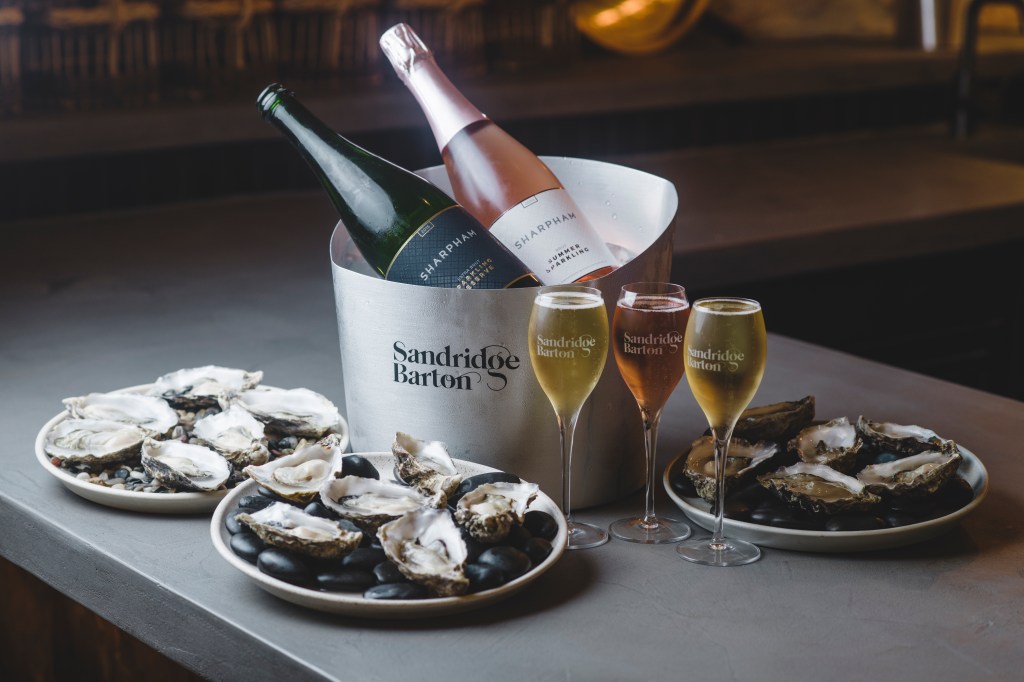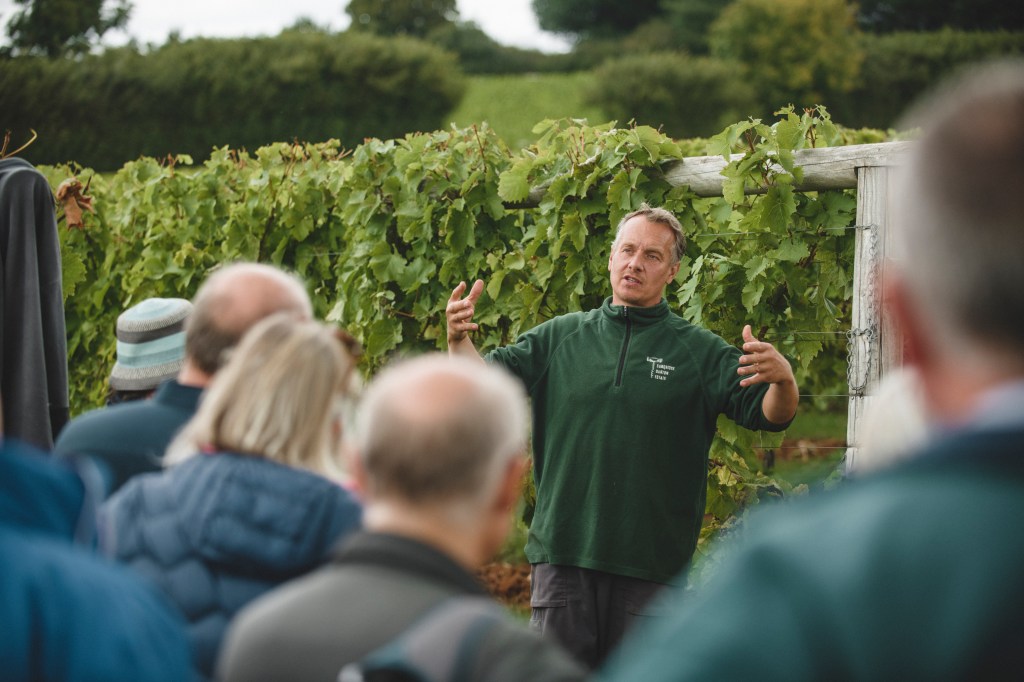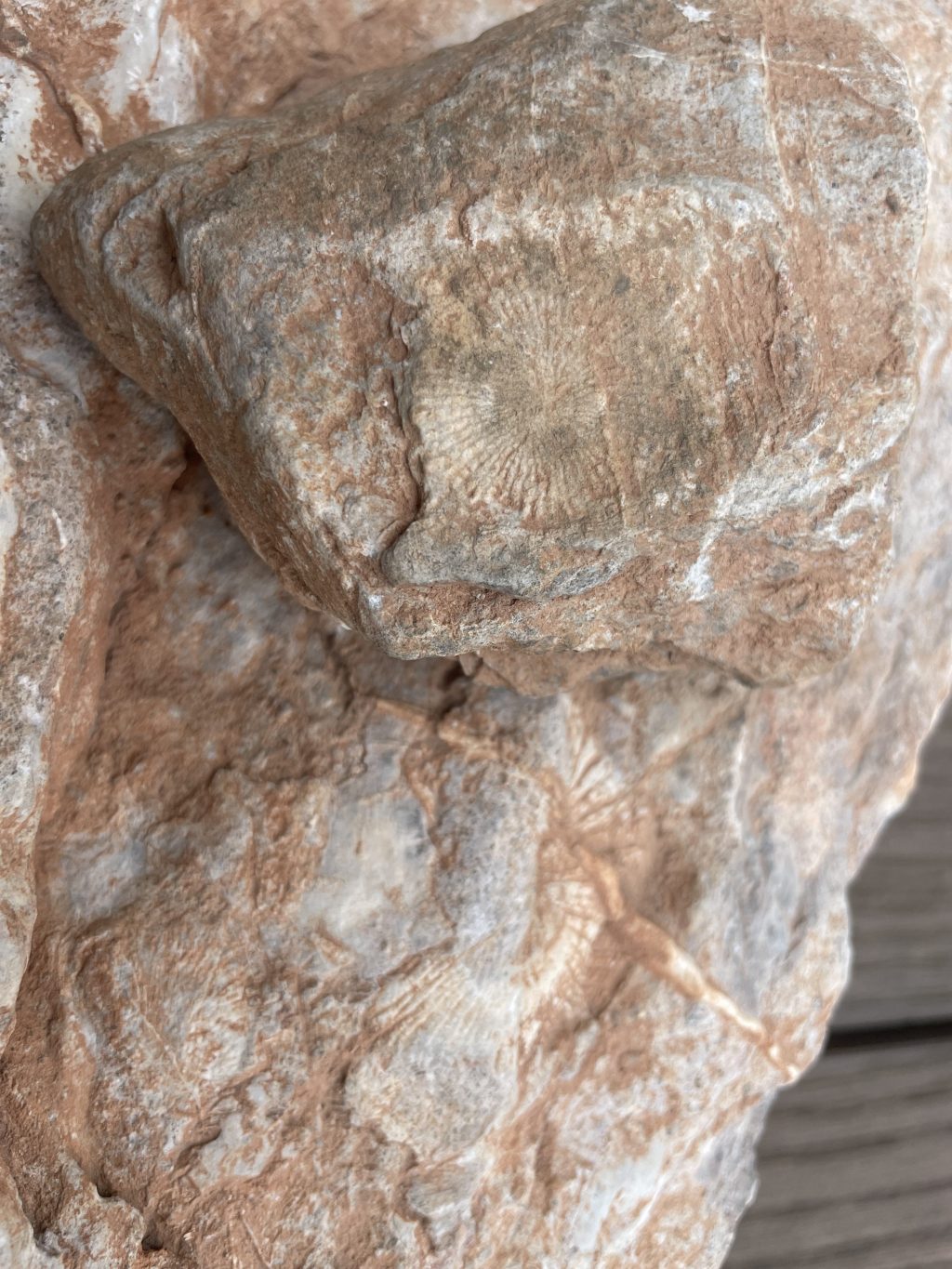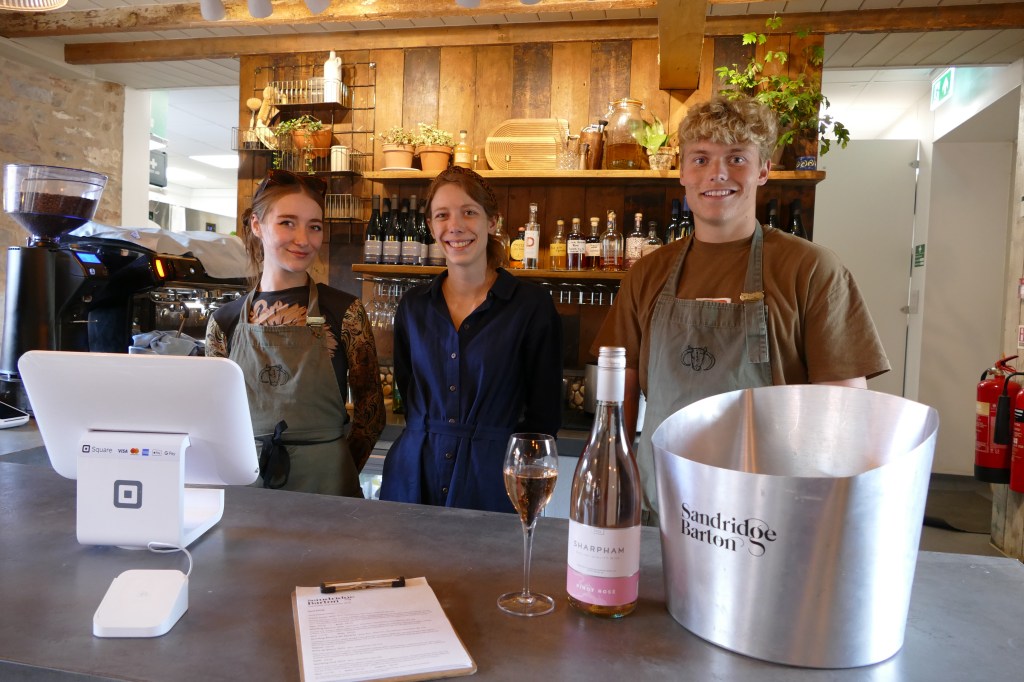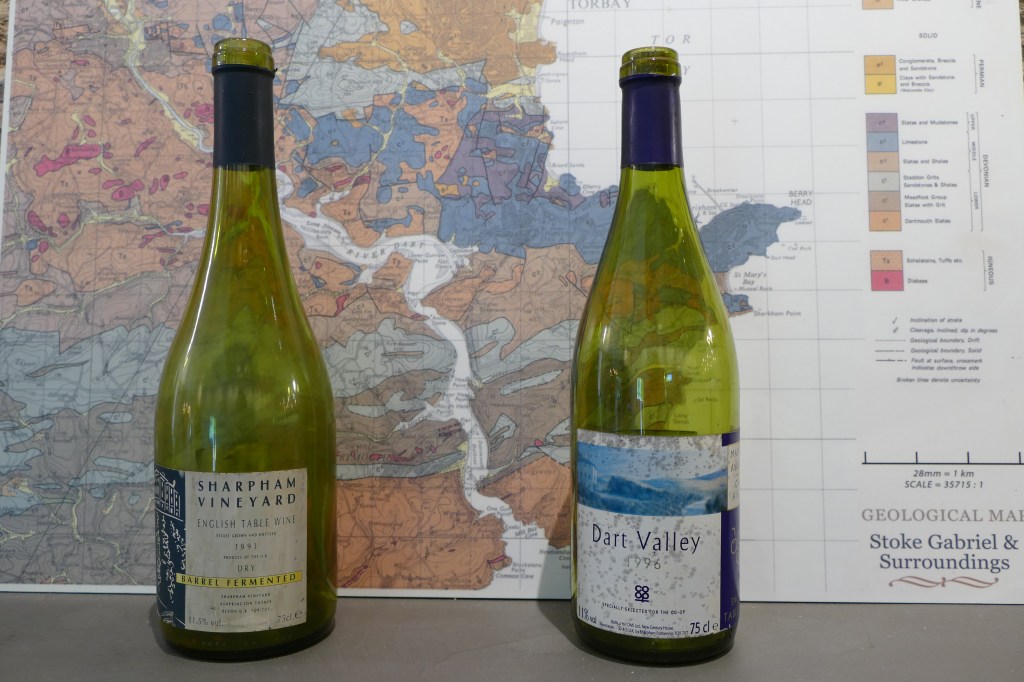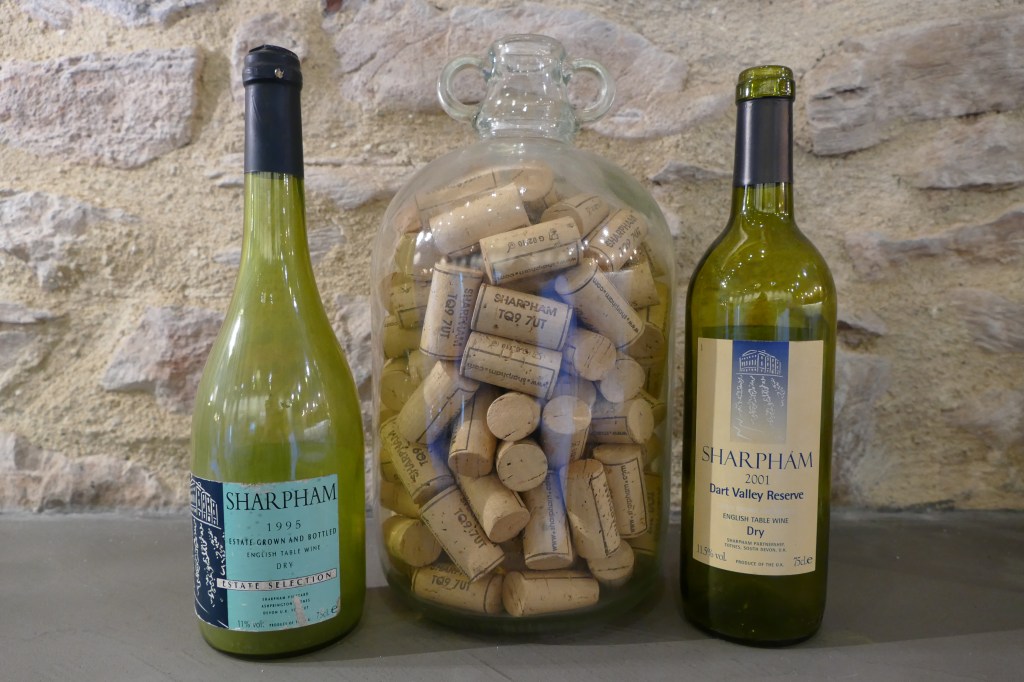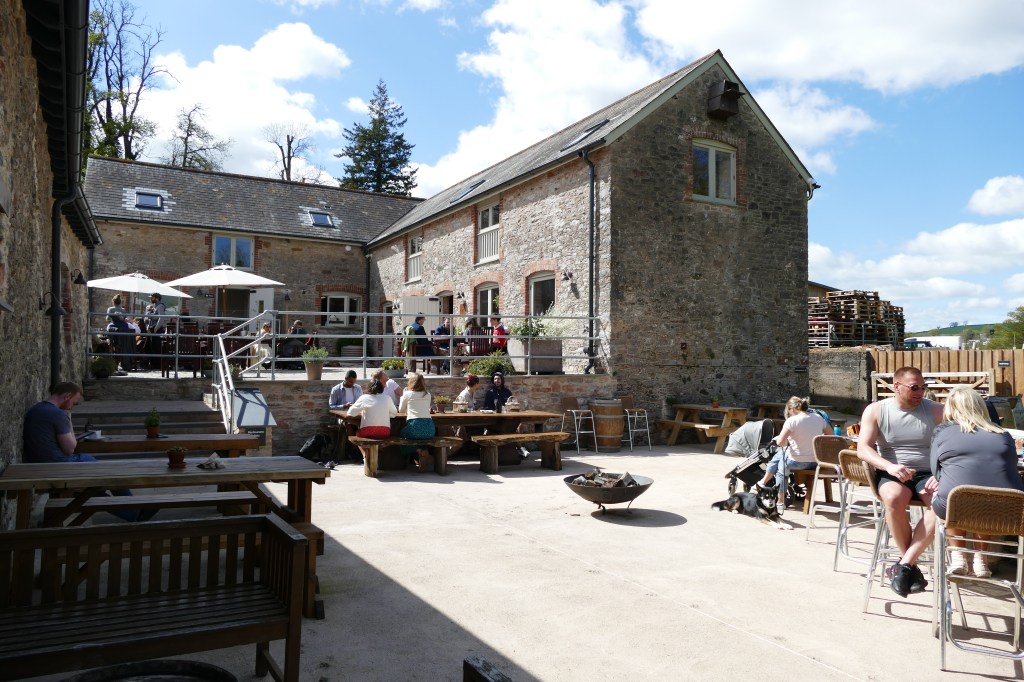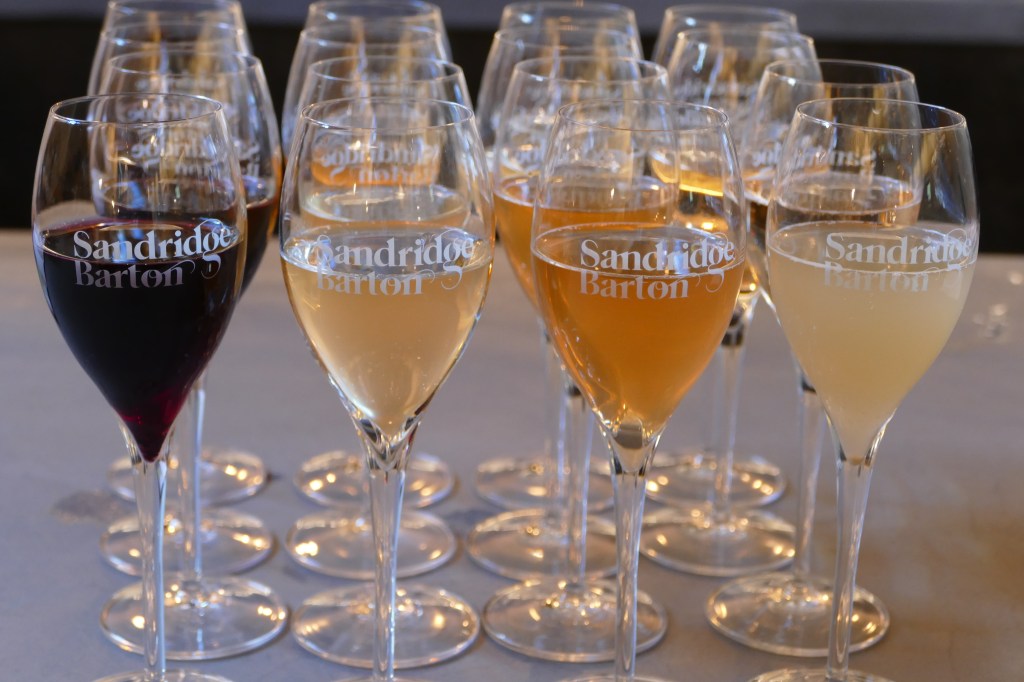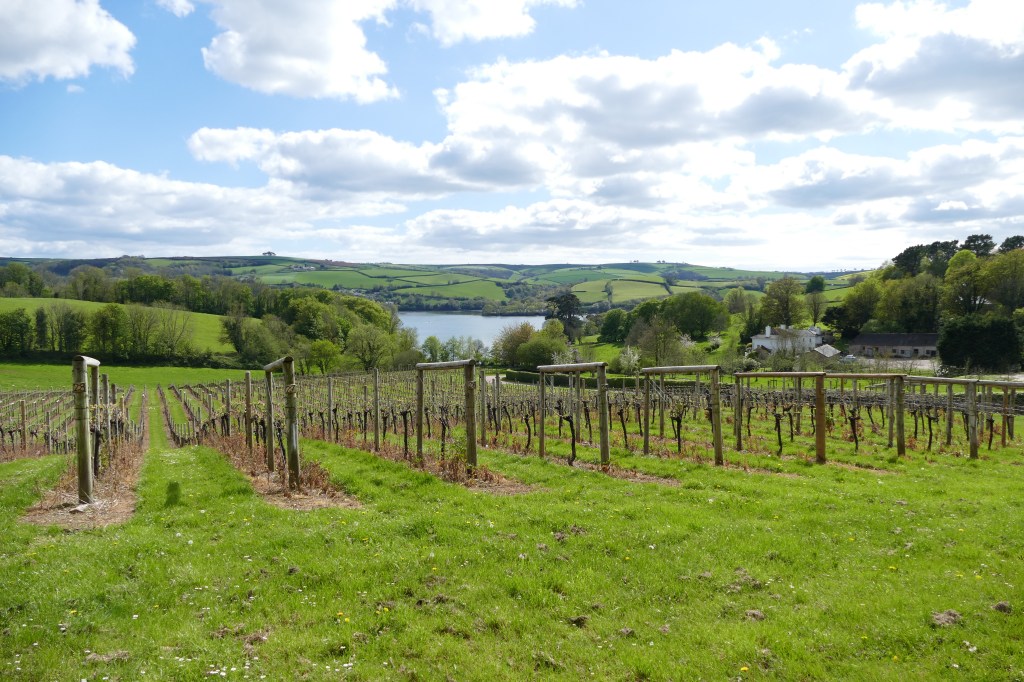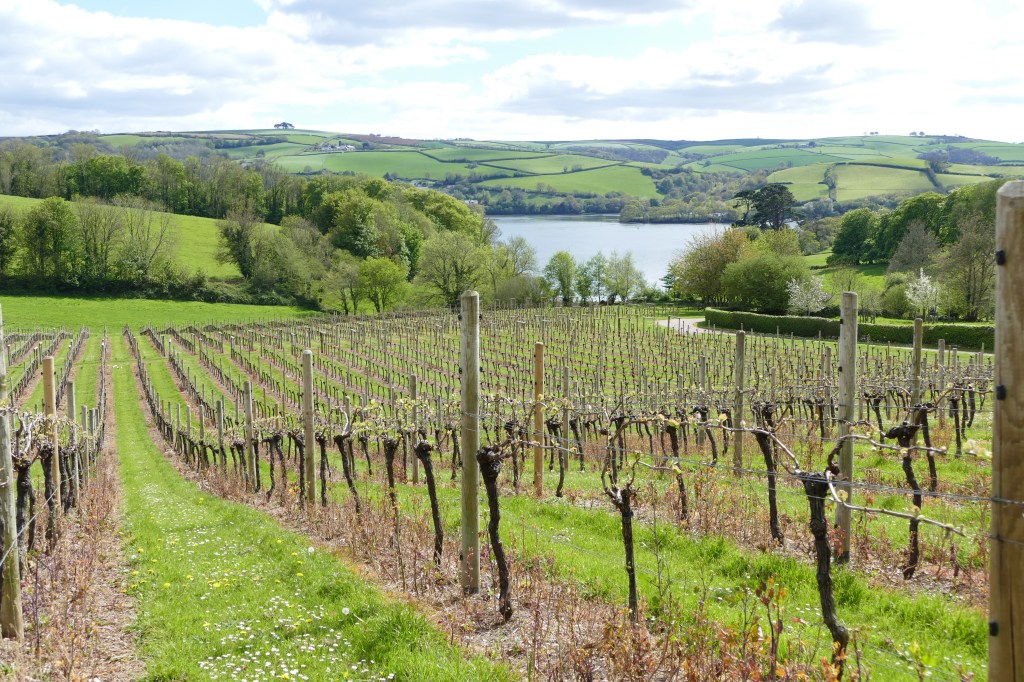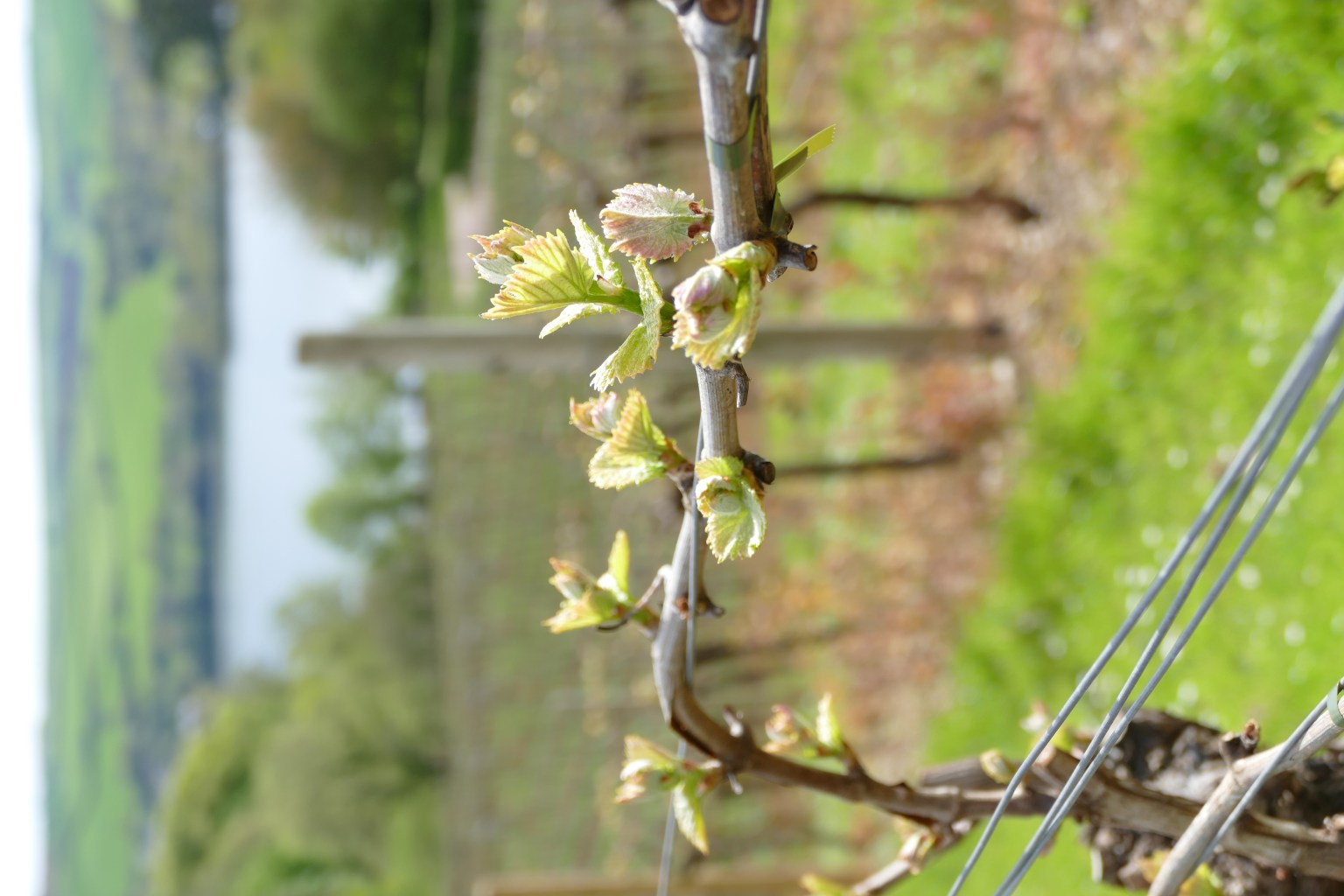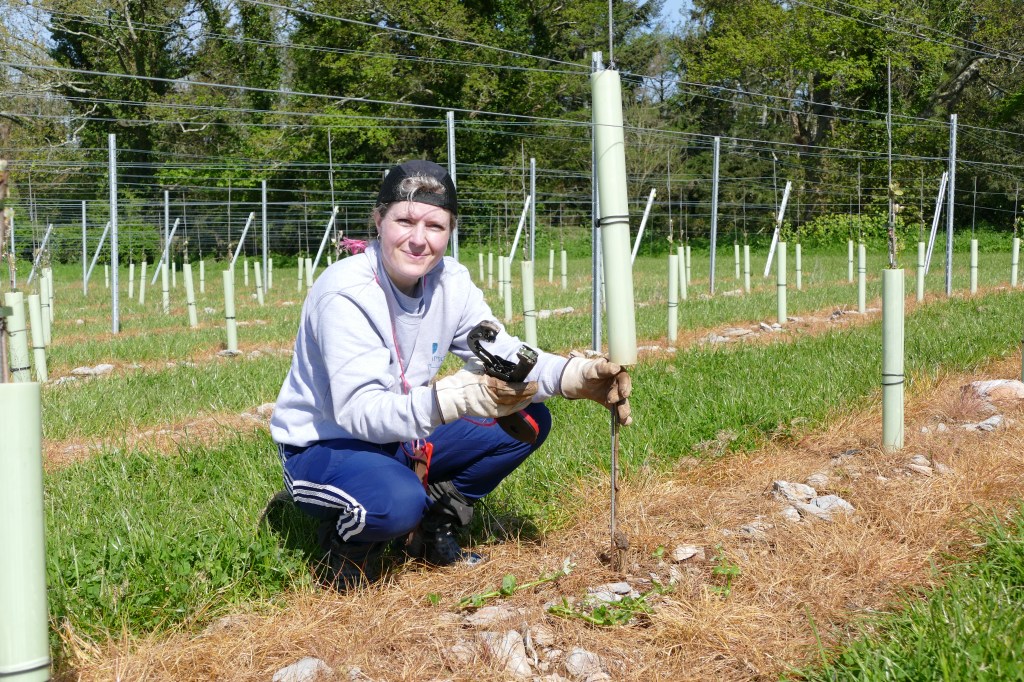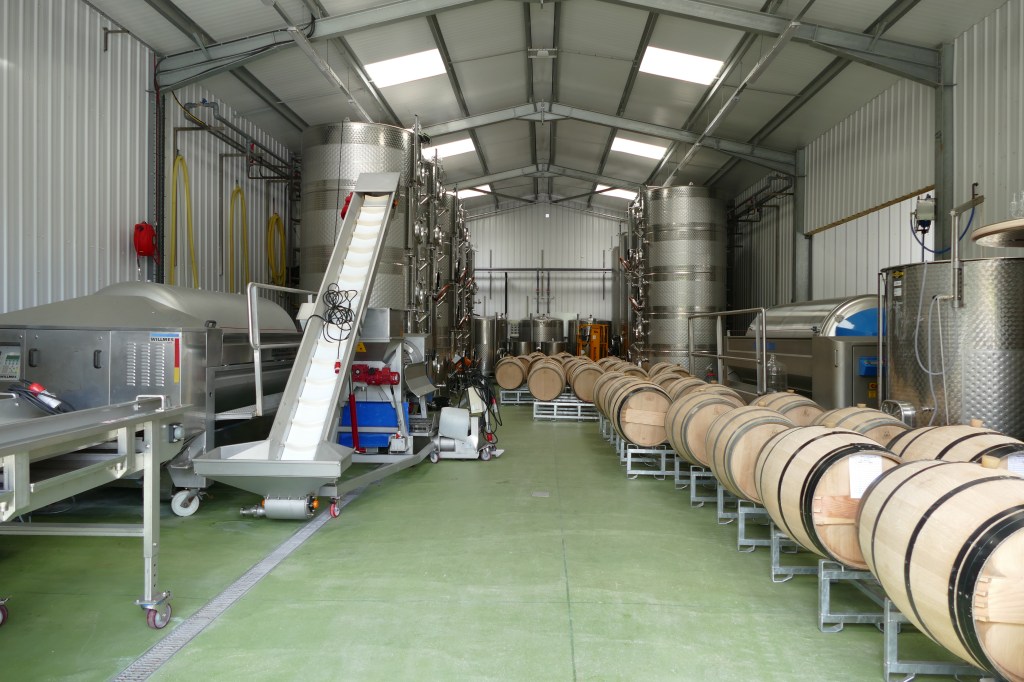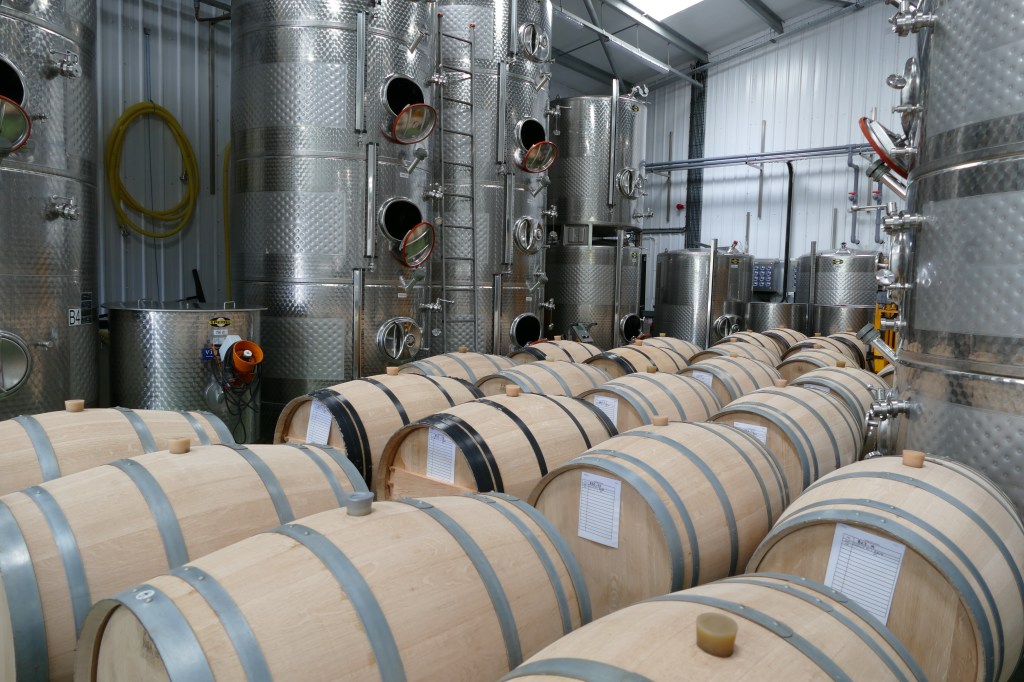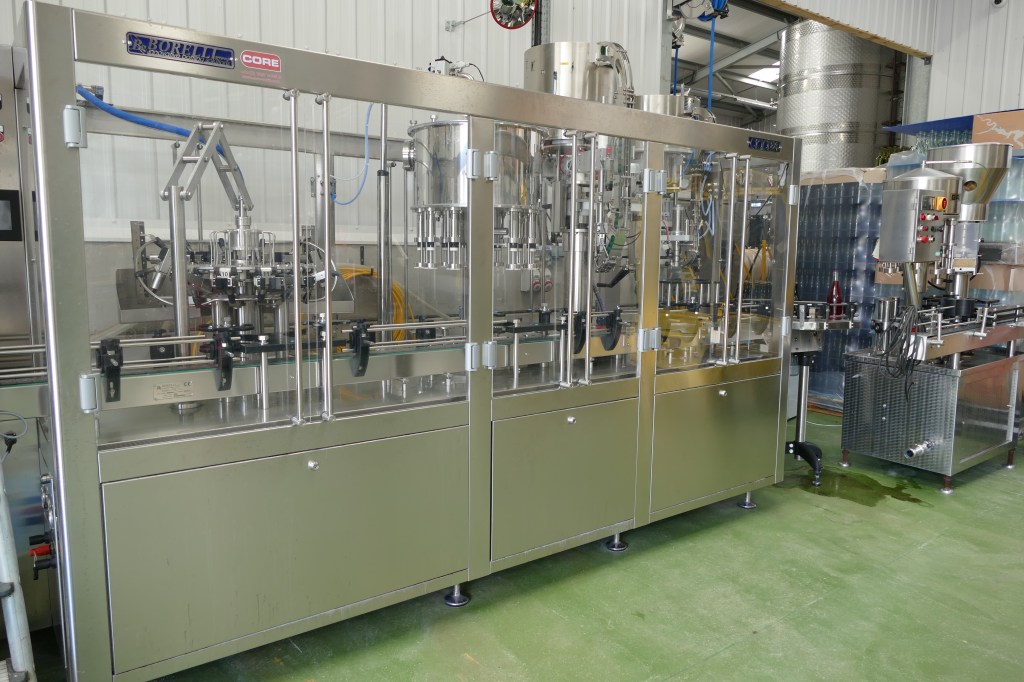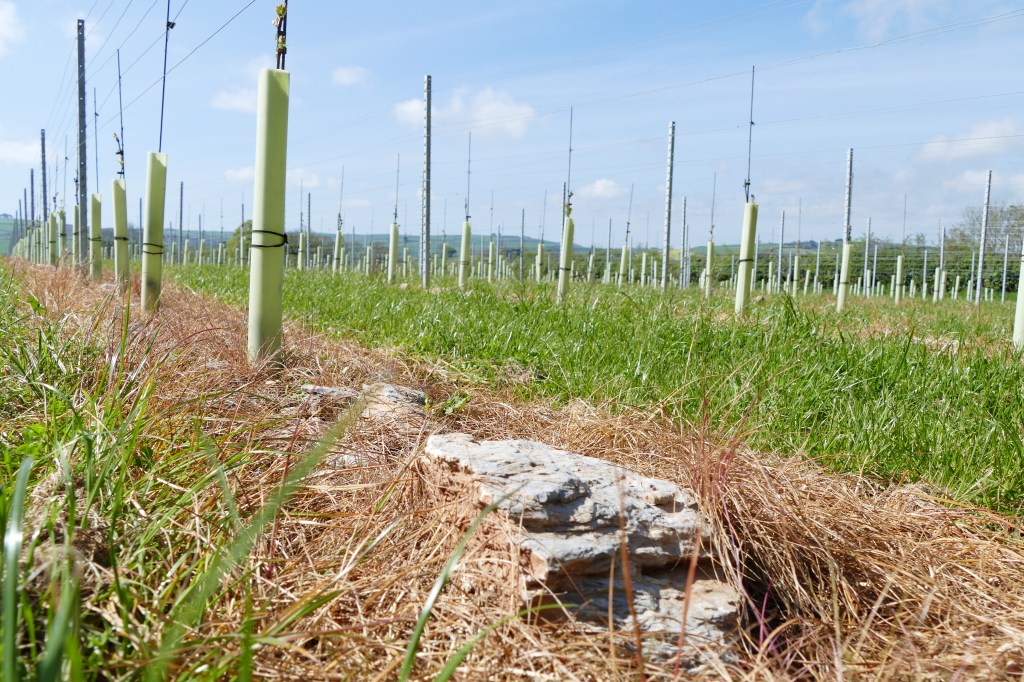A knowledge of the past helps us move into the future. This was evident as Vineyard visited Sandridge Barton, the home of Sharpham Wine.
The name Sharpham Wine will be familiar to many within the sphere of English Wine. Indeed, Sharpham Wines have been produced on the banks of the River Dart since the late 1980’s winning many awards. However, in 2020 Sharpham Wine moved across the river Dart to a new home on the Sandridge Barton Estate. The links between Sandridge Barton and Sharpham Wine had been forged a decade before the move when Sandridge Barton became a supplier of grapes to Sharpham Wines. Now with this exciting new move the businesses will grow together and the metaphorical inflorescences have started to flower.
Arriving at Sandridge Barton brings to mind the works of Kenneth Grahame. In his well loved book the Wind in the Willows he wrote: “The call of lush meadow grass, wet orchards, warm, insect haunted ponds, of browsing cattle, of haymaking and all the farm buildings clustering round the House of the Perfect Eaves…a hungry longing to hear the cuckoo’s note again.”
The cuckoo’s note is a pleasant accompaniment to the entire visit at Sandridge Barton. An increasingly rare sound in our countryside it is an indication of the sensitivity to the surroundings that have been shown at this vineyard and winery situated on the slopes of the River Dart, Devon.
Sandridge Barton is an estate of about 450 acres with a farming history dating back 1,000 years, now being in the ownership of the Moon family. A decade ago Sandridge Barton had 25 acres of vines and this number has now increased to 33 acres. Duncan Schwab CEO and Head Winemaker revealed: “In the next few months this figure will increase to 40 acres.”
The new plantings at the end of May will include Pinot Noir Précoce, Madeleine Angevine and Bacchus in a field that already has the name Reservoir View. Quite frankly the term view falls a long way short of the stunning scenery that surrounds Sandridge Barton.
The expansion of the vineyard has been overseen by Alex Davidson and his team “which varies in number from six to seven depending on the season,” he explained. Alex has been the vineyard manager at Sandridge Barton since 2012. During his long career in viticulture (35 years) he has worked across the South West. Starting at a small vineyard on the banks of the River Fowey Alex then moved to Camel Valley in Cornwall. At Camel Valley he gained experience of the whole industry “I even worked in the shop,” he said.
In 2021 vines were planted in what has always been known as Stoney Field. Stoney Field proved true to its name, “it took three weeks to remove stones from the surface in preparation before the team at VineWorks could plant the Pinot Noir and Chardonnay vines,” Duncan explained. “After we, as a team, had spent three weeks with four people, a tractor and a trailer, clearing stones by hand a local farmer said ‘I have got a stone picker,’” Duncan said laughing. Even after all this preparation, planting took far longer than would normally be expected. The reason for this is that Stoney Field is part of a limestone ridge which runs from Torbay and Berry head and finishes under Sandridge Barton. It is a geological anomaly in the Devon area and it is still possible to find ammonite fossils in Stoney field. The stones that have been cleared have been put to good use on the estate for pathways and wall building and are also used under the vines to provide a source of warmth, clear evidence that at Sandridge Barton every effort is taken to make the most of available natural resources ensuring these are not wasted or neglected.
Limestone is linked to some of the world’s great viticultural regions such as Burgundy, Champagne and the Rhone but is not common in the UK so its discovery on the banks of the river Dart is great news for English wine lovers.
On other parts of the Sandridge Barton Estate the soil is very iron rich and a Scott Henry system has been adapted for the vines here. The system can leave a wall of canopy which brings disease pressure so Alex decided to adapt the system slightly to best fit the environmental conditions and the soil. “We put down three canes instead of four and punched some holes in the canopy to relieve disease pressure and increase air flow,” he explained. This adapted system is nicknamed “the half Scott,” by Alex and the vineyard team.
The growing system for the limestone soil incorporates a double guyot “but if the vines are out of balance and start to produce internodal lengths of seven or eight inches then there is the ability to put more canes down if necessary,” said Duncan.
The system has been raised in height to accommodate Easy Care sheep (a breed that can be found on Dartmoor) which will be introduced into the Stoney Field site as part of the ever increasing efforts to produce wines in a sustainable way. Working with nature is an ongoing process and the move to the Sandridge Barton Estate has meant that this process can develop further.
Stoney Field contains a trial area of around half an acre and students on regenerative agriculture courses at Dartington college are working with the vineyard in these trial plots. One interesting technique is the application of a folic acid compound which utilises a waste product from the coal industry and provides beneficial compounds such as nitrogen, phosphorus and potash. The ability to explore new areas of regenerative viticulture has been made possible by the amalgamation of Sharpham Wines and Sandridge Barton on one site.
Speaking about the vineyard Duncan explained that in Stoney Field there are six clones of Pinot Noir and five clones of chardonnay. There are burgundy and sparkling wine clones and the F105 clone which is a sparkling wine clone that Duncan said is also capable of making an amazing red.
Diversity is a point of distinction at Sandridge Barton. Duncan explained: “It is nice to showcase what you can achieve with Madeleine Angevine as a single grape variety and yet create four or five different styles of wine from it.” These wines include the Dart Valley Release; Sharpham Estate Selection, which goes well with seafood, a speciality of the area; New Release; Col Fondo; and a natural wine called Tipley Hill. “As winemakers we really enjoy pushing the boundaries a little bit, starting to make more wines that have not been messed about with in the winery and retaining those amazing flavours. As soon as you start putting sulphur in and filtering you start changing those wines that are alive almost and dumb them down a little, so by unfiltering and unfining you have more fruit flavours. Using less sulphur also allows those fruit flavours to become incredible.”
The river Dart was a central part of the wines of Sharpham and that has continued with the move to the Sandridge Barton Estate. “We make wines in our locality from vines grown on the River Dart and we sell about 80% locally,” explained Duncan. Surrounded by tourist destinations including Salcombe, Dartmouth, Kingsbridge and Totnes there are plenty of places for food and wine lovers to visit. “Our remit is to sell to anyone who has a licence locally, in France the thought of drinking wine from another region would be unheard of and that is what we are trying to achieve,” Duncan added.
Duncan has passed his love of the area onto his daughter. The natural wine range is named Don’t Feed The Ponies and was inspired by a campaign that started when Duncan was taking his daughter Sienna to school across the moors. They saw at the side of the road several dead ponies and foals that had been lured too close to traffic by people who were taking grass cuttings up onto the moors for the ponies to feed from. In conjunction with other school children from Widdecombe, Sienna created a poster that can be seen across Dartmoor with its message ‘Don’t Feed the Ponies’. The wines created for this range include the minimal intervention orange wine ‘Little Bee 2021’ made from Pinot Gris and using indigenous yeast.
Annually 30,000 bottles of the Dart Valley Reserve are produced “that is the house wine in a lot of restaurants. It is well known in the area and has a great reputation,” Duncan said. It is Madeleine Angevine sometimes with additions of Bacchus or Pinot Blanc. “For us Madeleine Angevine has been the banker if you like” said Duncan. The Dart Valley reserve is made from free run and pressed juice. Around 10% of the blend spends its life in oak and has a touch of residual sugar “it is an easy drinking wine suitable for drinking on its own or with food,” added Duncan.
There are plans for reserve wines to be released “every year there is a barrel of Pinot Noir that you taste and just think wow, but it needs another year, so that will be put aside and eventually form a Sandridge Barton Range.” That journey has already started and Reserve Wines will be released soon. The first of these releases will be a Blanc de Noirs 2020 with 0g dosage followed by an unfined and unfiltered Pinot Noir of which 1,000 bottles were produced along with a Bacchus.
On the day of our visit Vineyard magazine were delighted to be given a sneak preview of these exciting new wines. Visitors to the WineGB stand at the London Wine Fair were also treated to a preview of the Pinot Noir.
The tidal river brings climate benefits to the vines that grow in this part of the south west. “There are not really late or early frosts and there is the opportunity of extended hang time for those varieties that need it,” explained Duncan. “The south east seems to be hotter during the actual growing season but the south west tends to get a warmer longer finish time,” he added.
The influence of climate change has been quite obvious and Duncan explained how in the early years of his experience in the south west Pinot Noir would fully ripen “maybe twice in ten years but now the Pinot Noir Précoce ripens every year. Even in 2021, we made amazing red from Pinot Noir Précoce but all the rest of the Pinot Noir had to go into sparkling.”
The 2022 harvest was very special at Sandridge Barton. “For me 2022 was the perfect year in the vineyard,” explained Alex. “Usually we are able to pick around eight tonnes of fruit a day but on just one day in 2022, 24 pickers were able to pick 11 tonnes of quality grapes,” continued Alex. Confirming this assessment of the 2022 harvest Duncan added: “We usually make 6,000 bottles of red but in 2022 we produced 22,000 bottles of red.”
Duncan, who is a trained surveyor, was born in Africa and spent some of his early years in the Middle East. He started work at Sharpham Wine in 1992. His father had planted a small vineyard in England in the early 1980’s (despite the general opinion that this was not the wisest course of action) and employed Duncan to survey the steep south facing field on the banks of the river Fowey. To his surprise Duncan found the whole process of the establishment and maintenance of a vineyard in England fascinating and has spent many years on what he called “a steep learning curve.” Duncan also pointed out that there are “not generations of history,” within viticulture in the UK but three decades of experience gave Duncan the ability to see the potential of the redundant farm buildings at Sandridge Barton which have subsequently become the visitor centre, café and Circa (a quite exquisite restaurant). In June 2022 Oz Clarke officially opened the new facilities at Sandridge Barton.
The visitor experience at Sandridge Barton is extensive and during visitor season there are two tours a day of the winery and vineyard. There were 10,000 visitors in 2022 and although this is not as many visitors as Sharpham received in their old location this number is sure to increase as word spreads that Sandridge Barton is the new home of Sharpham wine. As visitors tell their friends and family about the inclusive experience that encourages children to look for fossils and wildlife, allows adults to sample the amazing wines and gives the whole party an entertaining and enjoyable outdoor experience the reputation of Sandridge Barton as a tourist destination will develop.
The reason that people take vineyard tours varies and Duncan said: “The experience in the vineyard is as important as the experience in the winery.” With this in mind there are plans to improve the vineyard experiences in terms of creating a Vineyard Safari which allows the visitor to see the vines and then taste the single variety wines that come from those vines so they feel a connection to the story of the wines. “On tours the under forties are often looking for something different and want to be challenged on the palate,” said Charlie Brown an assistant winemaker. The Don’t Feed the Ponies Range is one way that this is being achieved but Sharpham has a history of exploring the challenging and different. Many years ago (at their previous location) using polytunnels and a lot of patience Sharpham actually managed to produce a Cabernet Sauvignon, Merlot wine blend of which there are just a few bottles remaining. This nicely illustrates how imaginative viticulture can be in the UK; something that the industry should treasure and preserve.
At Sandridge Barton there is an onsite shop selling local produce including locally roasted coffee, candles, grow your own herb pots and an extensive selection of cheese alongside the extensive collection of wines. One of the highlights of any vineyard and winery experience is the ability to sample the wines. At Sandridge Barton this is beautifully presented in the form of tasting baskets in the café/bar as well as in the restaurant.
The atmosphere at Circa is refined but relaxed and the staff are friendly and welcoming – even the plants in the restaurant were home grown by Mia who works in there. The menu is all about local food cooked well and is designed to create a shared experience. Kate the restaurant manager and her team have really captured the essence of developing strong family relationships through the unique joy that comes from the sharing of good food accompanied by good wine.
Whilst in the restaurant I reflected that throughout history strong societies such as the Egyptians, Greeks and the Romans placed high value on shared food experiences and the pandemic and subsequent lockdowns have proved to many just how precious these things are. All the wines served at Circa are produced on the estate which considering the choice available is astonishing.
On the day of our visit there was a very large party of diners who had decided to each have a glass of something different from the menu, a whim that most vineyards could not satisfy for such a large party but proved no challenge to the Circa team. With Sparkling, Rosé, White, Red and Natural wines there is something for every palate – even an estate produced sparkling cider is available (made using the same traditional method as sparkling wine) or sparkling elderflower made from wild estate elderflower (also made using the traditional method).
Sandridge Barton has wonderful accommodation available for visitors including The Boat House literally on the river Dart dating from the 18th Century and Sandridge Barton House, a six bedroomed Georgian Manor house. There is also Lower Well Farmhouse which is within sight of the visitor centre and winery.
The Winery at Sandridge Barton is purpose built and additionally there are offices and a conference space which will possibly be holding WSET classes in the future. The environment on the Sandridge Barton Estate which is the new home of Sharpham Wine will aid the education process by helping those enrolled on the courses to become fully immersed in the world of wine. Wine in the bottle can sometimes be divorced from the process of production and Duncan and his team work hard to establish this connection “ensuring the story of the wine justifies the purchase,” he said.
The fact that the winery is purpose built on site has been beneficial in many ways one of which is logistics. Sandridge Barton would previously have to move all the fruit from 25 acres across to the winery at Sharpham. “At harvest I would drive ten miles twice a day moving three tonnes of grapes each time,” explained Alex. Now with the purpose built winery on site, that fruit only has to travel a few hundred metres solving many a logistical headache at harvest.
The move to Sandridge Barton created an opportunity for the new winery to incorporate air source heat pumps, solar panels and rain water harvesting along with extra height concrete panels in the barrel room to reduce the amount of cooling required to keep the room temperature steady. The vineyard is part of the SWGB scheme and the winery is also working to incorporate as many sustainable practices as possible.
On entry to the winery the compartmentalised stainless steel tanks are eye catching. The tanks were supplied by Vigo and Andy Pegman, Divisional Director of Vigo commented: “Duncan approached us with requirements for Speidel wine tanks for fermentation and a full temperature control system to cover chilling and heating, both at product and cellar level. We provided Sandridge Barton with 83,000 litres of total tank capacity, a complete chilling system incorporating Quantor units for the white wine tanks, air-cooling for the barrel room, and a heating system for the red wine tanks. It was a privilege to work with Duncan and the Sandridge Barton team on this project.”
The taller tanks that reach right to the ceiling hold 10,400 litres but are able to be separated into up to six compartments creating more possibilities for the winemaking team. The placement of a sorting table is also very noticeable. To improve quality at harvest two people stand on each side of the sorting table separating any sub standard fruit. Although it seems that this would be a lengthy process when time is at a premium Duncan explained that the system allows a bin to be sorted quite quickly. The barrels are all second and third fill French oak Bordeaux, Duncan decided that new oak is too dominant for the wines he wants to make.
The wines that are produced at Sandridge Barton will continue to break new boundaries and will maintain the tradition of producing award winning wines that began decades ago at Sharpham. “Competitions are good for benchmarking,” said Paddy Gaunt a member of the winemaking team.
If the purpose built winery has provided logistical benefits for the vineyard team it has also benefitted the winery team. Bottling was previously outsourced which could at times create issues with availability but the new bottling line supplied by Core equipment has given the winery team the freedom that comes with in house control and an ability to process 1,800 bottles an hour. The natural wines are bottled under cork with wax instead of foil. Duncan explained that it did not seem quite in keeping to put foil on a natural wine. This lead to a discussion about the difficulty of opening wax sealed wines. “We did try just leaving the wines without the seal but people kept saying we had forgotten something,” Duncan said with a smile.
The state of the art winery will undertake contract work for other local vineyards that share their ethos – local wines produced locally. This includes a producer of PIWI varieties which will be a new experience for the winemaking team that seems to thrive on the new, the experimental and the different.
At Sandridge Barton the new home of Sharpham Wine it feels like the past has been wrapped lovingly and with great care in a new blanket and that future growth has been made possible because of the roots put down decades ago with a connection that flows like the River Dart itself, moving but integral, changing but constant.
- ©www.sghaywood.com
- ©www.sghaywood.com
- ©www.sghaywood.com
- Alex Davidson ©www.sghaywood.com
- A fossil found in Stoney Field
- Duncan Schwab, Peter Sudworth and Ian A’Court – laying down new roots
- Kate is the manager of the restaurant (centre) with part of her team Mia and Miles
- Libby in Stoney Field bud rubbing
- Oak
- An old Lime Kiln on the Sandridge Barton Estate
- Duncan Schwab (front), with Paddy Gaunt and Charlie Brown (top) from the winemaking team
- Using natural resources to keep the vines warm
For more like this, sign up for the FREE Vineyard newsletter here and receive all the latest viticulture news, reviews and insight




